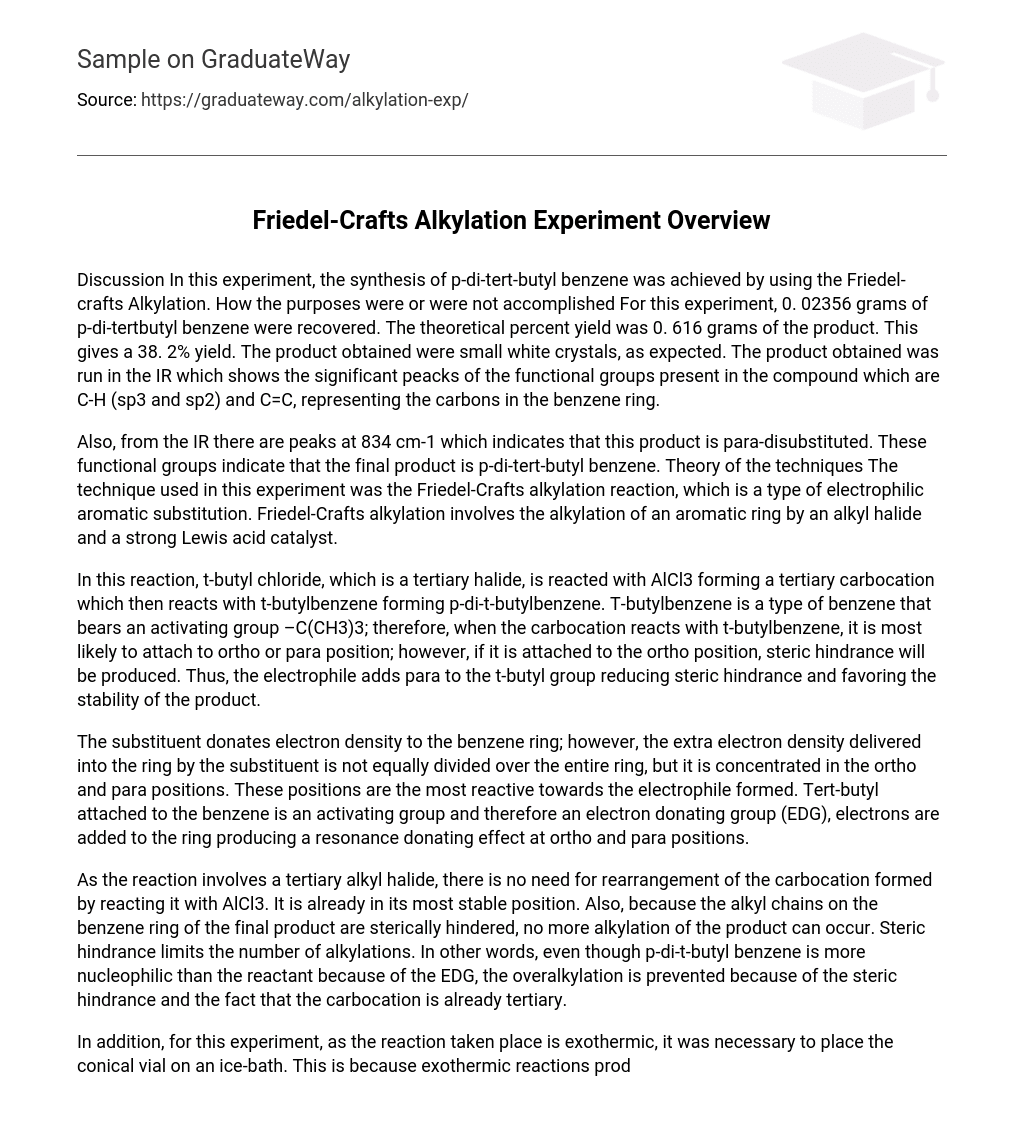Discussion In this experiment, the synthesis of p-di-tert-butyl benzene was achieved by using the Friedel-crafts Alkylation. How the purposes were or were not accomplished For this experiment, 0. 02356 grams of p-di-tertbutyl benzene were recovered. The theoretical percent yield was 0. 616 grams of the product. This gives a 38. 2% yield. The product obtained were small white crystals, as expected. The product obtained was run in the IR which shows the significant peacks of the functional groups present in the compound which are C-H (sp3 and sp2) and C=C, representing the carbons in the benzene ring.
Also, from the IR there are peaks at 834 cm-1 which indicates that this product is para-disubstituted. These functional groups indicate that the final product is p-di-tert-butyl benzene. Theory of the techniques The technique used in this experiment was the Friedel-Crafts alkylation reaction, which is a type of electrophilic aromatic substitution. Friedel-Crafts alkylation involves the alkylation of an aromatic ring by an alkyl halide and a strong Lewis acid catalyst.
In this reaction, t-butyl chloride, which is a tertiary halide, is reacted with AlCl3 forming a tertiary carbocation which then reacts with t-butylbenzene forming p-di-t-butylbenzene. T-butylbenzene is a type of benzene that bears an activating group –C(CH3)3; therefore, when the carbocation reacts with t-butylbenzene, it is most likely to attach to ortho or para position; however, if it is attached to the ortho position, steric hindrance will be produced. Thus, the electrophile adds para to the t-butyl group reducing steric hindrance and favoring the stability of the product.
The substituent donates electron density to the benzene ring; however, the extra electron density delivered into the ring by the substituent is not equally divided over the entire ring, but it is concentrated in the ortho and para positions. These positions are the most reactive towards the electrophile formed. Tert-butyl attached to the benzene is an activating group and therefore an electron donating group (EDG), electrons are added to the ring producing a resonance donating effect at ortho and para positions.
As the reaction involves a tertiary alkyl halide, there is no need for rearrangement of the carbocation formed by reacting it with AlCl3. It is already in its most stable position. Also, because the alkyl chains on the benzene ring of the final product are sterically hindered, no more alkylation of the product can occur. Steric hindrance limits the number of alkylations. In other words, even though p-di-t-butyl benzene is more nucleophilic than the reactant because of the EDG, the overalkylation is prevented because of the steric hindrance and the fact that the carbocation is already tertiary.
In addition, for this experiment, as the reaction taken place is exothermic, it was necessary to place the conical vial on an ice-bath. This is because exothermic reactions produce heat or may even be explosive. IR Analysis The IR spectrum shows peaks at 2097 cm-1 and 3052cm-1 indicating the presence of sp3 and sp2 of the C-H group. It also shows a peak at1640 cm-1 indicating the C=C of the benzene ring. Also there is a peak at 834 cm-1, indicating that the compound is para-disubstituted.
All of these functional groups are present in the structure of the p-di-tert-butyl benzene, meaning that, in fact, the product obtained was p-di-tert-butyl benzene. However, this product also contains an O-H group at 3433cm-1, this indicates the presence of water, meaning that the product was not pure. Sources of error The percent yield for the reaction was 38. 2%. This small percent yield was obtained because the product was lost each time it was transferred from a container to another.
The product was mostly lost after drying it with magnesium sulfate. This is because the product got trapped in the cotton when using a cotton-plugged pipette to separate it from the drying agent. Also, the final product showed a significant amount of water on the IR spectrum. This is due to the fact that students from other previous classes did not close the aluminum chloride properly which caused it to get impurities and react with water, which is shown in the IR. In conclusion, p-di-t-butyl benzene was synthetized via Friedel-Crafts Alkylation.





